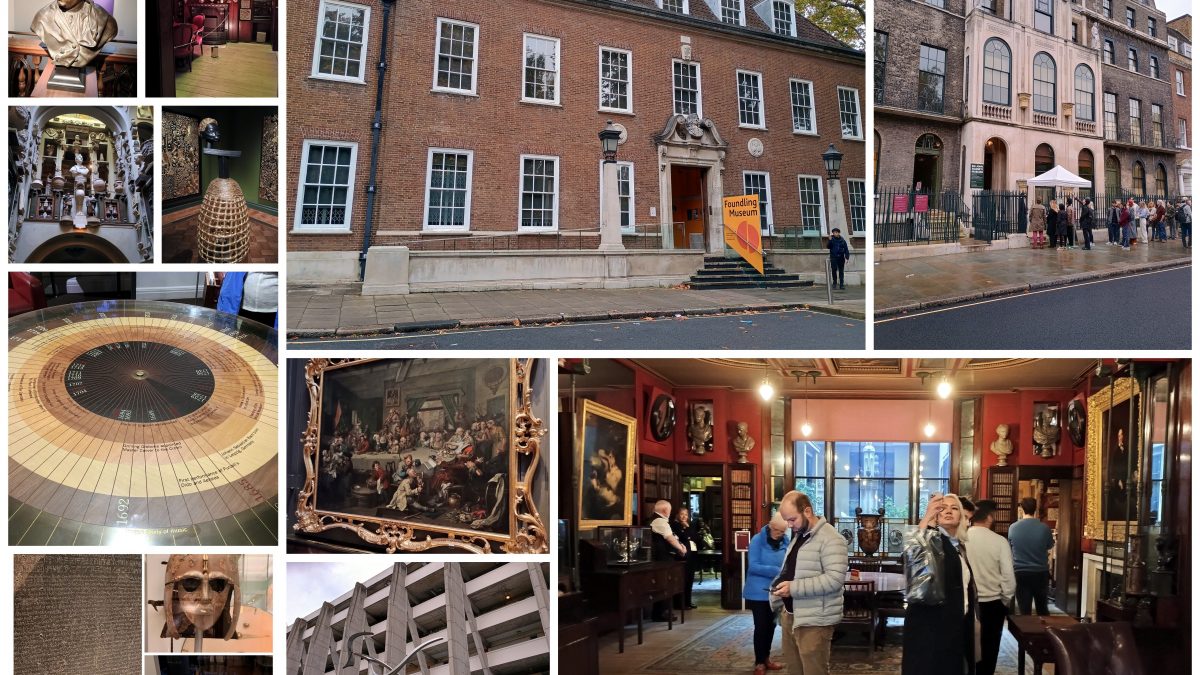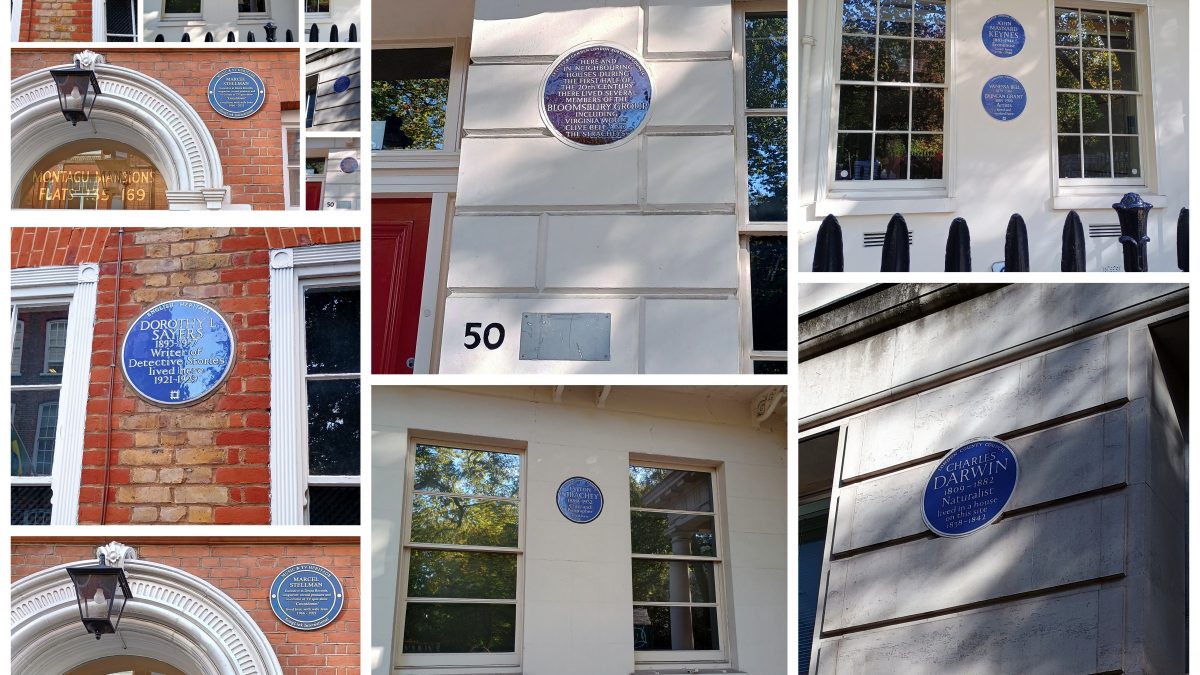A long awaited four night weekend return foray to London, the first since the pandemic, with the delay then further compounded by the longstanding disruption to the rail network! Prompted by a ‘weekend offer’, we stayed at the 5* Kimpton Fitzroy, which was an absolutely gorgeous building, with a superb marble laden interior that would probably be prohibitively expensive to replicate today. The Yorkshireman feels duty bound to point out that our stay was only possible because of the ‘offer’ and, even then, he had to go and lie down in a darkened room after the booking had been made! Would definitely repeat it though. 🙂
A quick check in and then a short stroll around to The Lamb pub for a quick beer (a pub that features antique screens in the main bar and beautiful Victorian decor, along with a (not so) secret back garden for those wanting to drink and dine alfresco. A walk up and down Lamb’s Conduit Street to catch up on the ‘independent scene’ and then back to the hotel for a very pleasant evening meal in the brasserie.
We had a tentative agenda for the three days we were there, based largely around the museums that were all fairly local to Bloomsbury. Meant that, other than the journey to and from the hotel, we didn’t have to use the tube at all during the break, which was also part of the plan. So, in order of visits, we took in the following :-
- Charles Dickens Museum (Friday) and the British Museum (evening)
- Foundling and John Soane’s Museum (Saturday)
- Montagu Mansions and Sunday stroll (Sunday would you believe)
Only potential visit we didn’t do was the Postal museum but then we had to leave one for next time; and there is always the Hunterian, but that couldn’t I don’t think be done on a full stomach. 🙂
We went to the Dickens Museum on Friday afternoon, having walked down to Leicester Square to see if there were any suitable ‘on the day’ theatre tickets. We quite fancied the modern retelling of Oedipus but we both baulked at the non-discounted £160 ticket price!! The Dickens Museum (at 48 Doughty Street, his London home for a time) was laid out as it may have looked when Charles Dickens lived here andyou’ll feel as though you have stepped back in time. I don’t know how much of the layout was true to Dickens time but the house was presented over five floors and the key objects on display were certainly authentic. Of the myriad on show, the portraits of Charles and his wife, the original writing desk, his court suit (‘fancy dress’ he called it) and the portrait of Dickenses’ children all caught our eye. Well worth a look, but I should also register the point that he and his family only lived here around three years; however, in that time he managed to write The Pickwick Papers, Oliver Twist and Nicholas Nickleby.
On the Friday evening we made a late call to visit the British Museum to take advantage of the extended opening hours. After finally discovering the “back entrance” for free entry (I think it was exhibition tickets only at the front), we decided to view a few of what were described as the ‘Don’t Miss‘ Exhibits. We started with the Rosetta Stone (the key to deciphering hieroglyphs), onto The Lewis Chessmen (probably the most famous chess set in the world but who has read the Lewis Trilogy – I have, he says smugly, but I can’t say I’ve ever noticed any direct connections, other than the setting obviously). Then on to the original Sutton Hoo hoard, including the original ‘Sutton Hoo helmet‘, one of only four complete helmets from the Anglo Saxon period. Only ever seen the replica before, on our visits to the site, just outside Woodbridge. Good to be back in the BM after so many years and still free for all at the moment – the debate will no doubt rage on.
After breakfast on Saturday morning set off to the Foundling Museum, another tick from Mrs. No Name’s list! The museum is actually housed in what was the administrative house of the charity itself. The Museum is in Brunswick Square, London and tells the story of the Foundling Hospital, Britain’s first home for children at risk of abandonment. The museum houses the nationally important Foundling Hospital Collection. I didn’t know that the museum only reopened in 2004 and I definitely wasn’t aware of the Hogarth and Handel connections, but both these artists are central to the charity story; not forgetting the philanthropist Thomas Coram who established the hospital in 1739. After 17 years of tireless campaigning, Coram was finally granted a Royal charter by King George II, enabling him to set up the UK’s first children’s charity in Bloomsbury, London. The ground floor was given over to the history of the hospital but the museum is also responsible for the Foundling Museum Collection, which includes the Gerald Coke Handel Collection. The Wikipedia entry overviews the place succinctly so I won’t repeat it here, other than to mention the Picture Gallery, a reconstruction of the original Picture Gallery in the West Wing of the hospital. The place hosts works of art by some of Britain’s most prominent eighteenth-century artists: William Hogarth, Thomas Gainsborough, Joshua Reynolds, Louis-Francois Roubiliac and many others. These paintings and sculptures, donated by the artists themselves, were given in order to support the Foundling Hospital and effectively made the institution the UK’s first public art gallery. I may be boring you more than ever, but I found it both expertly put together and fascinating. So much so, we bought the book! Even had a look at a bit of Brutalist architecture (it was the adjacent Brunswick Centre and I’m not that much of a fan, but it is Grade II listed now) on the way to our next port of call.
We then walked on to the John Soane’s Museum, where we had to join a queue to, once again, get the benefit of free entry. After entering we enjoyed the ambience of a lovely but perfectly normal drawing room. Beyond it though the house is a complete shock to the system (in the nicest possible way). I know it’s undergone restoration but now the building is full of drawing rooms, a picture room, study and dressing room, picture room recesses and others, all restored to their original colour schemes and in most cases having their original sequences of objects reinstated. Soane’s three courtyards were also restored with his pasticcio (a column of architectural fragments) being reinstated in the monument court at the heart of the museum. Again, highlights include the Picture Room and the Model Room, along with the Sarcophagus of Seti. Located in the Sepulchral Chamber in the basement of Sir John Soane’s Museum, this vast sarcophagus was built to entomb the Egyptian Pharaoh Seti I (died 1279 BC). Seti I ruled Egypt at a time when it was an important military power; his son, Ramesses II, is famed for his great military victories against the Hittite Empire. Upon his death, Seti I was interred in a lavish tomb in the Valley of the Kings, within which this sarcophagus, containing his coffin and mummy, was originally housed. Again, rather than replicate here, just go to the museum website and suck it all up!! And for those who might baulk at the queues, to this day numbers are limited to ninety visitors at a time and, once inside, the labyrinth like layout quickly confirms both the correctness of that decision and the wisdom of those who are prepared to patiently wait in line. I’m ashamed to admit I was unaware of this gem but it had been on Mrs. No Name’s list for a number of years. So, mission accomplished and I hope she wasn’t too disappointed (spoiler alert – she wasn’t).
In the evening, we decided to eat at a different venue and so we booked to dine at the “Blue Door Bistro” at the Montague on the Gardens hotel, which was only a five minute stroll from where we were staying. I’d spotted the place previously because I saw it offers jazz evenings on a weekly basis and thought that’s interesting. Apropos of nothing really! Anyway, it was a lovely meal with unpretentious but first class service throughout.
Having completed our loose itinerary, Sunday was a leisurely affair designed to blow away the cobwebs and allow us to wander around the Bloomsbury environs at our own pace. We had one very general destination in mind and that was Montagu Mansions, an apartment block just off Baker Street and about forty minutes from our hotel. We took a slight and interesting detour which involved a loop around Marylebone Road but this fortuitously brought us to the statue/memorial to Joseph Lister in Portland Place. He was a British surgeon, medical scientist, experimental pathologist and pioneer of antiseptic surgery and preventive healthcare, although, technically, not a particularly exceptional surgeon (says Wikipedia). The visit to Montagu Mansions was simply in ‘honour’ of the BBC TV Series, “A House Through Time” in which David Olusoga describes what happened to the residents of the apartment building when bombs fell on London between 1940 and 1941. We can indeed confirm it’s still standing, as we knew that information would be critically important for our loyal audience. 😞
I should at this time point out that Sunday involved the obligatory coffee sojourns, as on all other days of this London break, as well as occasional forays into the occasional public house along the way. On this occasion we stopped at the Fitzrovia pub on the way back, followed by a stroll up and down Marylebone High Street and an associated array of independent shops.
It should also be noted that even when one is not on a dedicated Blue Plaque trek, one can’t help but come across them, seemingly on every corner. This explosion in the proliferation of said plaques has led me to develop the newly coined and patented affliction term known as plaqueophobia (plaque phobia). Of course, it’s also an excuse to add a collage to this blog showcasing a few of the plaques that we happened upon as we travailed on our merry way!
All in all, a highly enjoyable return to the capital city, all the better because of the choice of hotel, the decision to avoid the pitfalls of the Underground and, for that matter, the maelstrom that is Leicester Square, Oxford Circus and the like. The term ‘London villages’ might be a slight misnomer but the quieter, leafier London does exist and has plenty to offer. Roll on next time. 😄





